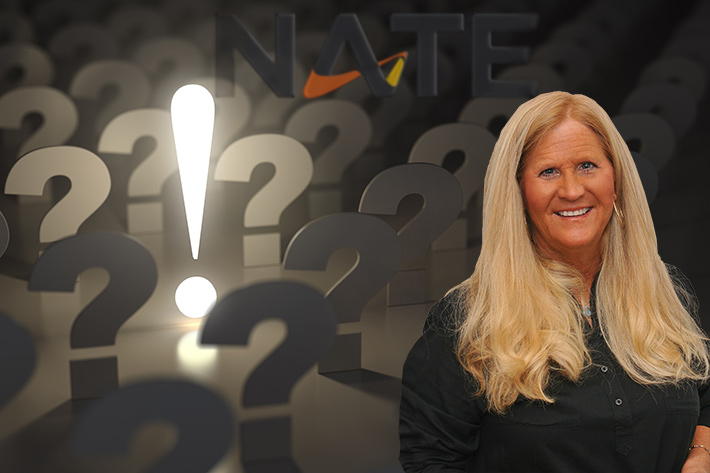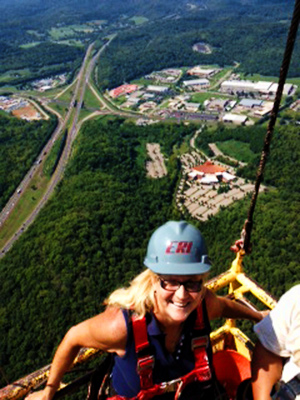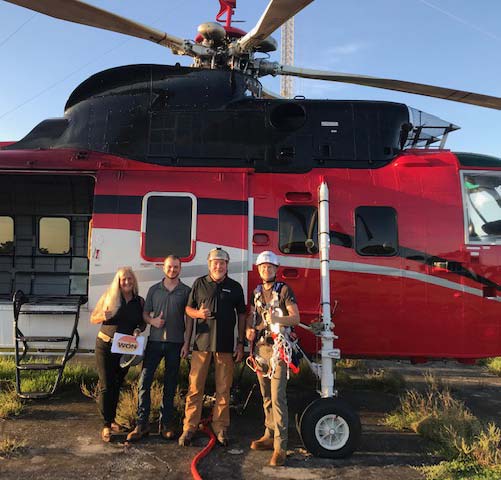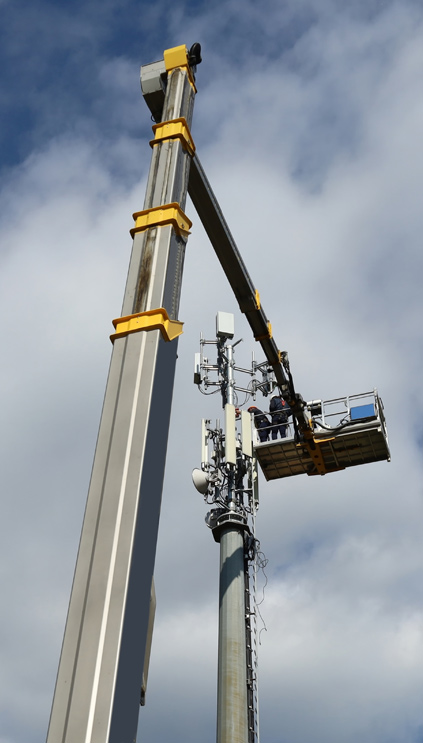
THE NEW ‘EXPLANATION’ POINT OF CONTACT for safety, health and compliance at NATE is well-known and highly respected subject matter expert Kathy Stieler. Wireless Estimator had the opportunity this morning to ask Stieler about a frequently questioned safety issue regarding rules on exiting an aerial lift to a tower. Her guidance is provided below.
NATE: The Communications Infrastructure Contractors Association has announced the hiring of Kathy Stieler as Director of Safety, Health & Compliance, a new staff position established by the Association. Stieler officially began her duties with NATE this morning.

Kathy Stieler
Stieler, a long-time industry subject matter expert and safety professional, joins NATE after serving as Director, ERI Installations and Safety since 2012. During her tenure at ERI Installations, Stieler’s leadership was instrumental in managing the company’s tower crews through a safe and successful broadcast repack transition.
As the NATE Director of Safety, Health & Compliance, Stieler will be tasked with directing, developing, and overseeing the general health and safety policies and procedures of the Association to ensure its safety materials and best practices documents comply with OSHA and other applicable state and local regulations and standards. In her new role, Stieler will also be available to provide technical subject matter expertise to the Association’s member companies, as well as helping these businesses navigate the often onerous compliance onboarding process.
“Today, I get to embark on an amazing journey that will allow me to work alongside the NATE staff and to work for the Association’s member companies whom I respect so much,” stated Stieler.
“I am excited and honored to have this opportunity to assist the NATE membership as we work toward our common goals to ensure the continued well-being of tower and communications infrastructure personnel, and to progress toward safer standards and practices within the industry. My passion for safety is well known by all who know me. I hope to pass that passion along to everyone as we work side by side,” Stieler added.
“NATE is elated to welcome Kathy Stieler to the team,” said NATE Chairman Jimmy Miller from Gulfport, Mississippi.
“Through the establishment of this Director of Safety, Health & Compliance position, NATE is doubling down on safety and investing directly into our growing membership of companies. Kathy will be a tremendous asset and I encourage member companies to leverage her expertise to enhance their respective safety cultures,” added Miller.
STIELER’S FIRST QUESTION ON HER FIRST DAY OF WORK
 Wireless Estimator: Wireless Estimator:
Your question is an intriguing one. Oddly enough, three years ago, the A10.48 committee was looking at adding a chapter to the A10.48 standard on mobile elevating work platforms (MEWP). We spent countless hours researching this topic, and decided collectively, the amount of information that is already available in the construction industry on the topic of MEWPs is so effective and extensive, that nothing needed to be added to A10.48 that was “specifically” for the telecommunications industry. I believe the difference in opinions that you have stated on exiting the MEWP stems from looking at three specific sources. Regulations, Consensus Standards, and contractual obligation that may apply. Regulations on this subject can be found in OSHA – CFR 1926.453. There are several letters of interpretation – specifically stating, “or the worker leaves the safety of the work platform, an additional fall protection device would be required.” Here are a few links that address exiting a MEWP, in the ANSI/SIAI A92 Consensus Standard. https://www.genielift.com/en/about-genie/news/2018/12/04/ansi-a92 https://www.osha.gov/laws-regs/standardinterpretations/2001-05-03-0 https://www.seaa.net/news/guidelines-for-exiting-a-boom-lift-onto-an-adjacent-structure https://www.ipaf.org/en-us/resource-library/exiting-platform-height-e2 In all of the articles, you will note that according to ANSI/SIAI A92, to exit a MEWP, the operator must develop a documented safe use or transition plan that includes a detailed safe risk assessment, JHA, as well as develop a rescue plan that all must be trained on. This Safe Work / Transition Plan must be created and implemented, and be authorized in writing. The bottom line: When the need arises to exit a boom platform at height – develop a plan and follow the plan. Although the Consensus Standard provides a method that allows for exiting a MEWP, contractors must always consider the contractual requirements of their clients. Does your client have a policy on exiting aerial lifts? And if so, what is the policy? Some clients strictly forbid exiting the MEWP, while others allow it, when following the regulations and standards. |
An OSHA meeting piqued the Purdue student’s interest in safety
Stieler is a 1979 graduate of Purdue University, earning a Bachelor of Science from the School of Management. Her focus of study was Labor Relations with a Minor in Psychology.
Stieler informed Wireless Estimator that in her final year at Purdue, her father, who owned Swanson-Nunn Electric Company in Evansville, Indiana, asked her if she wanted to accompany him to an OSHA meeting to discuss a grounding citation.

Active in Women of NATE (WON), Kathy Stieler is pictured with FCC Commissioner Brendan Carr, at right, in Florida. Carr welcomed the opportunity to be on a tower when one of Stieler’s ERI crews was performing repack work.
It was resolved in Swanson-Nunn’s favor since they were in compliance, but the meeting with IOSHA’s director and ensuing conversations piqued Stieler’s interest in safety and industry regulations, and she welcomed the challenge to accept the position of the company’s first personnel and safety director, and the first female construction safety and health director in the Evansville area.
She engaged with the organization’s leaders to integrate an effective safety and health culture into a successful business, meeting the needs of the business and having a positive impact on retention and workforce development.
Her duties included the human resource functions, as well as safety and health. This included a proactive approach to equipment inspections, record keeping, OSHA logs, risk mitigation/management, safety pre-qualifications, DOT compliance, and OSHA relations.
During her tenure, she worked with the team to reduce the corporate EMR factor from 1.39 to .70 and impacted the operating cost of the business in a positive manner.
Stieler instituted a program to train and develop a union workforce that worked in 28 states. This workforce varied from 300 to 500 employees, all needing to meet the safety, health, quality, and productivity requirements of the business.
The success of this program was recognized by others and she was hired by the IBEW / NECA Joint Apprenticeship Training Committee to teach the OSHA 10 course to all 700 IBEW Local 16 electricians.
The program that Stieler developed for Swanson-Nunn was recognized nationally and was highlighted in the National Electrical Contractors magazine for an effective corporate safety and health program.
She subsequently purchased Reddinger Constructors, Inc., whose work included industrial plant maintenance, lock and dams, and new “big box” development. Stieler’s corporate safety and health program at RCI was awarded the Business Roundtable Superior Corporate Safety Recognition.
Steiler has stellar credentials in the wireless industry
In 2011, Stieler had the opportunity to work with Electronics Research and became the corporate safety and health director in July of 2012. The telecommunications Industry was experiencing explosive growth at this time and it was essential that organizations had business centric safety and health programs in place. Engaging with the business needs, Steiler was able to support the existing resources and enhance the sub-contractor pool for the FCC’s Broadcast Repack
In March of 2013, she took over the role of Director of ERI Installations, Safety and Health.
Stieler currently holds a Tower Specialty Contractor License in Florida, and recently passed the NASCLA exam which is used by state contractor licensing agencies to test commercial general building contractor candidates who are applying for a contractor’s license in multiple jurisdictions.
Stieler is active as a member of the A10.48 standard for the telecommunications industry. In addition, she is an editor for the Telecommunications Industry Foundation’s planning advisory notices and white papers.
She is also currently serving on the American National Standards Institute for Construction and Demolition Operations Committee (A10) as an alternate and as a formal observer representing NATE.
Stieler contributed to the Tower Foreman Task Force for the National Wireless Safety Association and is currently participating on the Telecommunications Industry Registered Apprenticeship Program Resource Development Committee.
Stieler and her husband Mick have been married for 40 years and have three daughters and six grandchildren.
Stieler can be reached via email at kathy@natehome.com.















 Do you have any information regarding industry thoughts and rules on exiting an aerial lift to a tower? Some individuals state it is strictly forbidden, yet we’re being told by others that as long as it is on your JHA and you have a supervisor’s approval, it is allowed if done safely.
Do you have any information regarding industry thoughts and rules on exiting an aerial lift to a tower? Some individuals state it is strictly forbidden, yet we’re being told by others that as long as it is on your JHA and you have a supervisor’s approval, it is allowed if done safely.  Kathy Stieler:
Kathy Stieler:
